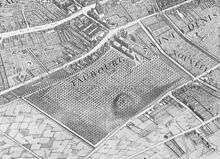Prison Saint-Lazare

The Prison Saint-Lazare was a prison in the 10th arrondissement of Paris, France.
History
Originally a leprosarium founded on the road from Paris to Saint-Denis at the boundary of the marshy area of the former River Seine bank in the 12th century. It was ceded on 7 January 1632 to St. Vincent de Paul and the Congregation of the Mission he had founded. At this stage it became a place of detention for people who had become an embarrassment to their families: an enclosure for "black sheep" who had brought disgrace to their relatives.
The prison was situated in the enclos Saint-Lazare, the largest enclosure in Paris until the end of the 18th century, between the Rue de Paradis to its south, the Rue du Faubourg-Saint-Denis to its east, the Boulevard de la Chapelle to its north and the Rue Sainte-Anne to its west (today the Rue du Faubourg Poissonnière). Its site is now marked by the Church of Saint-Vincent-de-Paul.
The building was converted to a prison at the time of the Reign of Terror in 1793, then a women's prison in the early nineteenth century, its land having been seized and re-allotted little by little since the Revolution. It was largely demolished in 1935, with the Assistance publique - Hôpitaux de Paris installing itself in the remaining buildings, where they remained until recently. Only the prison infirmary and chapel (built by Louis-Pierre Baltard in 1834) remain of the prison, with the latter to be seen in the square Alban-Satragne (107, rue du Faubourg-Saint-Denis) in the 10th arrondissement. The surviving remains of the Saint-Lazare prison were inscribed on the supplementary inventory of historic monuments in November 2005.[1]
A song by Aristide Bruant entitled À Saint-Lazare is named after the prison.
Famous prisoners
Pre-Revolution
- Henri de Saint-Simon,[2] French social theorist and one of the chief founders of Christian socialism [3]
During the Revolution
- François-Joseph Bélanger, architect
- André Chénier, poet
- Hubert Robert, painter
- Marquis de Sade, writer and libertine
- Joseph-Benoît Suvée, painter
- Charles-Louis Trudaine, conseiller au Parlement
- Jean-Antoine Roucher, receveur des gabelles, poet, portrayed several times by Hubert Robert
- Thomas de Treil de Pardailhan, former baron and député for Paris in the Legislative Assembly
Post-Revolution
- Louise Michel, communard
- Mata Hari, spy
- Léonie Biard, Victor Hugo's mistress
Sources
- Jacques Hillairet, Gibets, Piloris et Cachots du vieux Paris, éditions de Minuit, Paris, 1956 (ISBN 2707312754).
- (French) Appel des dernières victimes de la terreur à la prison Saint-Lazare à Paris les 7-9 Thermidor an II by Charles-Louis Muller (1815–1892), painting held at the Musée national du château de Versailles.
Notes
- ↑ ARRETE N° 2005 - 2347 portant inscription au titre des monuments historiques de l'ensemble des bâtiments dus à l'architecte Louis-Pierre Baltard: les façades et toitures de l'ancienne infirmerie, le sol de la cour et la totalité de la chapelle de l'ancienne prison, devenue Hôpital Saint-Lazare, sis 1 à 5 square Alban-Satragne et 107 rue du Faubourg-Saint-Denis à PARIS (l0ème); situés sur la parcelle n° 48 d'une contenance de 1 ha 03 a 12 ca, figurant au cadastre section AP et appartenant à la Ville de Paris.
CONSIDERANT que les bâtiments subsistants de l'ancienne prison Saint-Lazare constituent l'un des rares exemples parisiens d'architecture néo-classique construits par Louis-Pierre Baltard et qu'à ce titre ils présentent un intérêt d'art et d'histoire suffisant pour en rendre désirable la préservation et les classer au titre de monuments historiques. - ↑ Durkheim, E. (1959) [1928] Socialism, London: Routledge and Kegan Paul Ltd.
- ↑ Encyclopaedia Britannica (2014) Henri de Saint-Simon, available online at http://www.britannica.com/EBchecked/topic/518228/Henri-de-Saint-Simon (accessed 17/01/2014)
Coordinates: 48°52′32″N 2°21′16″E / 48.87556°N 2.35444°E